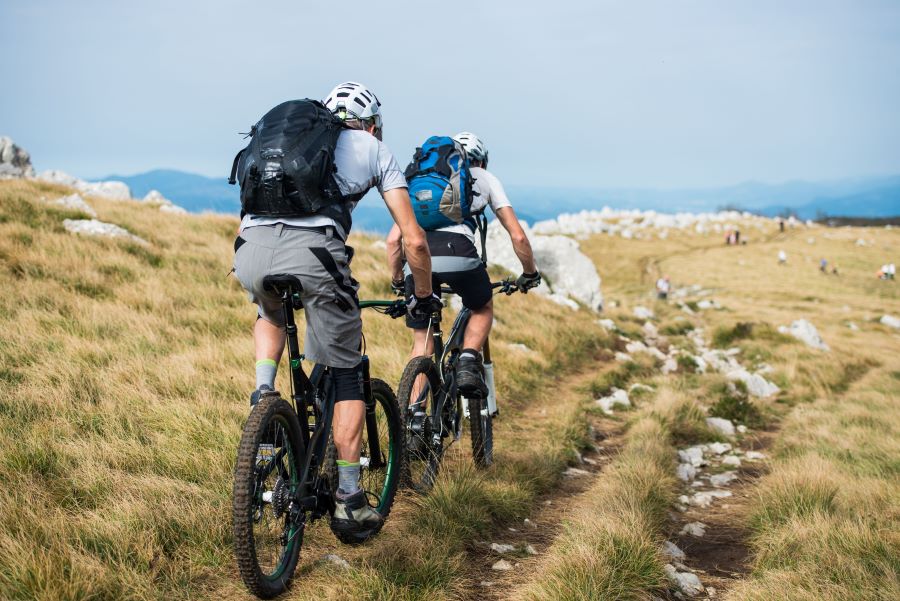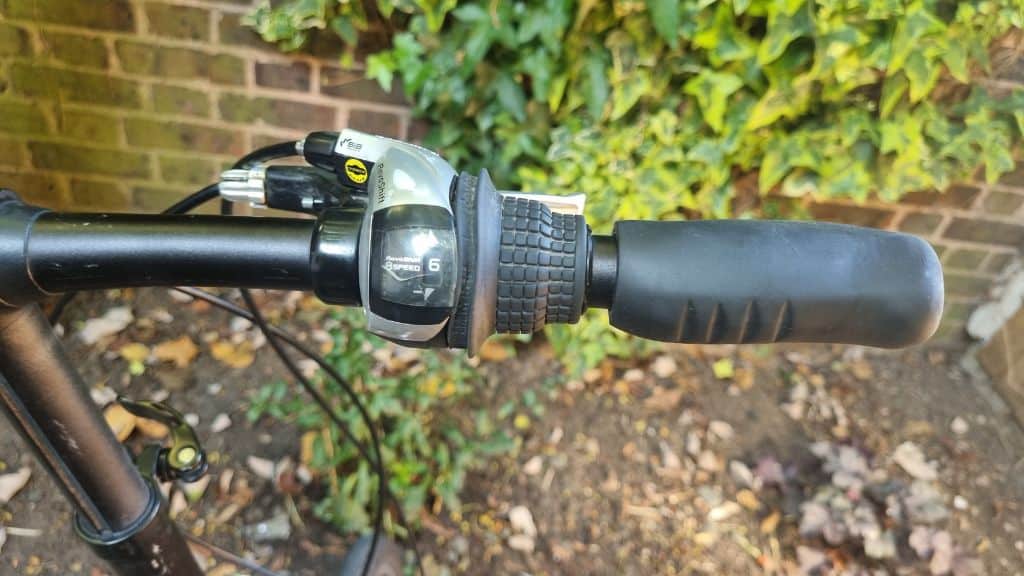This post may contain affiliate links. If you click an affiliate link and make a purchase, I may earn a commission. Also, as an Amazon Associate, I earn from qualifying purchases.--
If you’re a new cycling enthusiast, you must have quite a few questions about bicycle gearing. A common one is, what is a high gear on a bike?
In this post, we go over everything you need to know about high gear on a bike, from how it can help you achieve to how it differs from low and medium gear. Stick around!

What Is a High Gear on a Bike?
Bike gearing exists to make your cycling experience smoother and to make your bike adaptable to different terrain.
High gear on a bike, often called big gear, is used for cycling at a high speed on regular terrain. This gear allows you to move faster while applying some pressure to the pedals.
High gear is ideal for climbing down hills because it helps stabilize the bike. It moves you faster with less pedaling speed but more power.
To reach the bike’s highest gear, you combine the biggest front chainring with the smallest rear cog. This will give you a ratio of multiple full-tire rotations to fewer pedaling cycles/revolutions.

What Is a Low Gear on a Bike?
Low gears, or easy gears, are the ones used when you want to pedal more than you want to be fast. This gear is best for beginners, as it allows for easy control over the bike’s speed.
There will be little to no resistance while pedaling with this gear engaged. That said, it’ll take you a while to get where you’re going.
It does a great job keeping the bike on the ground at a steady speed. That’s why low gear is the best for climbing up hills, but not descending from them.
You can reach your lowest gear by combining the smallest front chainring with the largest rear cog. This will cause a ratio of a lower number of tire rotations on terrain to a bigger number of the pedaling cycle.
What Is a Middle Gear on a Bike?
Using a middle gear on your bike means that you’ll have enough speed on you without having to pedal furiously. A middle gear is ideal for normal steady roads and everyday destinations.
You only need to create an average ratio between your front chainrings and rear cogs to use a middle gear. Experiment around with the middle gears on your bike to find the perfect ratio for you. This will allow you to have a fun ride without much energy being exerted.

Bike Gears Summarized
This table demonstrates the different gear options and when you should be using them.
| Gear Choice | Front Chainring | Rear Cog | When to Use |
| High Gear | Large | Small | Fast terrains / Descending a hill |
| Middle Gear | Small / Average | Average | Day-to-day bike use / Steady roads |
| Low Gear | Small | Large | Beginners / Climbing up a hill |
Tips for Better Gear Handling
If you’re ready to go experimenting with your bike gearing, then there are a few tips that would help you and your bike stay safe.
1. Avoid Cross Chaining
Cross chaining is when you’re combining a large front chainring with a large rear cog, or a small/small combination.
This crossing strains the drivetrain and may result in components wearing out too soon. If that happens, you’ll find the chain slipping and not shifting properly, which could be very frustrating to deal with while cycling.
It’s okay to cross chains for a short while, like for a fast hill climb, but don’t overdo it.
2. Keep Your Pedaling Steady
Try several gear combinations on your bike to see which one is more comfortable for you to use while consistently pedaling.
Don’t pick a gear that requires a lot of attention to your pedaling and constant changes in speed and power. This choice would make cycling an unenjoyable experience rather than a fun one.
Be sure to consider your cadence. Your cadence is also known as the number of revolutions per minute.
Consider the movement in your legs to figure out which gear is more suitable for your preferred cadence. This will ensure you enjoy riding your bike without being too slow or too sore.
3. Keep an Eye on the Road
Knowing your gears and when to shift them would be of no use if you don’t keep an eye on the road ahead of you.
Consider the terrain you’re on and create a mind map of which gears you’d need to use in case of seeing some obstacles ahead.
This technique would keep your head in the game and rarely cause you any inconvenience as you’re cycling.
Multiple Gears: Are They Worth It?
Bikes have a variety of gear and gear ratios. To determine how many gears you have, check the number of chainrings and cogs on your bike.
If you have three front chainrings and 10 rear cogs, chances are you have a 30-speed bicycle, which means you have 30 different gears to discover and learn.
However, is it advantageous if you’ve got more gears in your bike, or is it not that big of a deal?
Well, if you think having more gears on your bike means you’ll be faster than a one-gear bike, then you’re wrong. Gears exist to make the cycling experience more enjoyable by giving you multiple speed and resistance options.
If you didn’t dedicate time to learning those gears and when to use them, you could be slower than someone on a single-gear bike.
More gearing options will benefit you if you want to stay active, seek adventure, or spend the entire day outdoors.
On the other hand, if you simply want an appropriate means of transportation without sweating afterward, you’re more of a less-gear person.
Sometimes you can have three front chainrings and 10 rear cogs but have a bike with less than 30 speeds. This not-very-odd situation happens when the gears overlap.
So, the first front chainring combined with one of the middle rear cogs could give you the same speed as when it’s the last front chainring with another rear cog.
To make it more straightforward, we’ll be listing some pros and cons that could be helpful for you to decide whether you want a bike with more or fewer gears.
Pros and Cons of More Gear
Having more gear could seem advantageous on a surface level, but you should consider the downsides as well.
Pros
- Perfect for exploring various terrain
- Ideal for long distances
- More gear options to explore
Cons
- Results in a heavier bike
- An extra shifter for the front chainrings
- Harder to maintain
Pros and Cons of Less Gear
Before deciding on starting with something small, you should realize the perks that you might be missing out on.
Pros
- Low maintenance
- Easier to handle
- Less hustle with the shifter
Cons
- Limits your speed range
- Hard to stabilize on an unsteady road
Best Bike Gear For Beginners
If all this gear talk overwhelms you while you’re trying to find a suitable bike, then worry not! Here are a couple of suggestions that are ideal for newbies.
1. 7-Speed Bike
One of the best options you can start with, as a beginner cyclist, is a 7-speed bike. It has one chainring and seven rear cogs.
This combination allows for a great deal of control while still offering a range of gearing options to experiment with.
A 7-speed bike is also perfect for cycling uphill. It makes the ride smooth and is enough to give you the perfect rhythm needed while pedaling.
2. Single-Gear Bike
One-speed bicycles have a single freewheeling cog that enables the rear wheel to turn without the pedals moving.
Using this bike as a beginner would spare you all the hassle of shifting gears while still going pretty fast.
Such bikes are simple, affordable, and very easy to maintain.
However, having a rear freewheel means that whenever the bike is moving, you should keep pedaling, which can be an inconvenience to some people.
How to Shift Gears on a Bike
For a newbie, occasionally changing gears could sound challenging. That being said, it will be practically instinctive once you get the hang of it.
Most gear shifters include two levers or shifters for the rear cogs that you can adjust to switch between higher and lower ranges.
That means, depending on your bike, shifting between gears is as simple as just pulling or pushing a small lever with a couple of fingers.
Similar to using the brakes, you should learn when to shift your speed to stay safe and away from inconveniences.
As we mentioned before, the principal advice we could give you regarding shifting is to keep an eye on the road.
Paying close attention will help when you’re supposed to shift into a higher or a lower gear if you’re going to a different terrain.
You should also be aware of when you want to speed up or slow down to be able to shift smoothly.

Wrapping Up
High gear on a bike might seem like loads of fun at first glance, and they are, but remember that different gearing levels are best utilized when the rider understands them.
So, experiment around with your bike and its gears! Don’t be intimidated by their numbers and try to find the speed levels that fit you the most.
Find your perfect rhythm and cadence, and use your gears accordingly!
